Монополия.ppt
- Количество слайдов: 71
 «Сулейман Демирел атындағы Университет» «Экономика» факультеті Монополия (Monopoly) аға оқытушы: Бектұрғанова С. Ө Copyright © 2001 by Harcourt, Inc. .
«Сулейман Демирел атындағы Университет» «Экономика» факультеті Монополия (Monopoly) аға оқытушы: Бектұрғанова С. Ө Copyright © 2001 by Harcourt, Inc. .
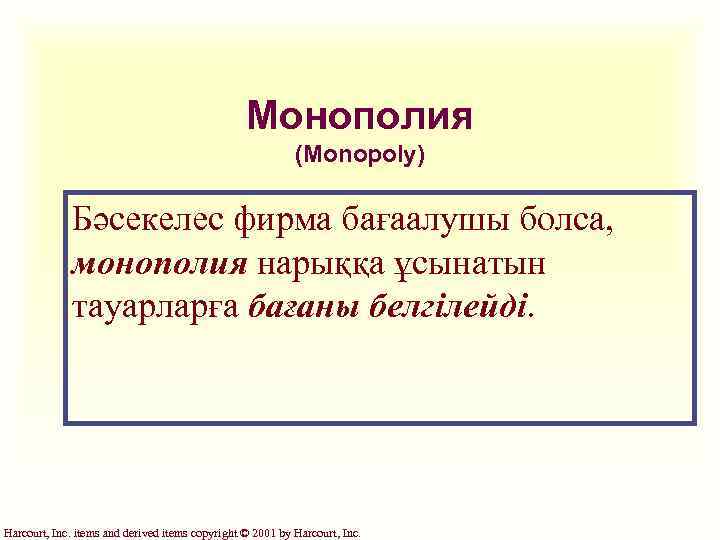 Монополия (Monopoly) Бәсекелес фирма бағаалушы болса, монополия нарыққа ұсынатын тауарларға бағаны белгілейді. Harcourt, Inc. items and derived items copyright © 2001 by Harcourt, Inc.
Монополия (Monopoly) Бәсекелес фирма бағаалушы болса, монополия нарыққа ұсынатын тауарларға бағаны белгілейді. Harcourt, Inc. items and derived items copyright © 2001 by Harcourt, Inc.
 Монополия Фирма монополияға ие болады: Ø егер осы өнімді жалғыз өндіруші болса; Ø жақын субституттары болмаса. Harcourt, Inc. items and derived items copyright © 2001 by Harcourt, Inc.
Монополия Фирма монополияға ие болады: Ø егер осы өнімді жалғыз өндіруші болса; Ø жақын субституттары болмаса. Harcourt, Inc. items and derived items copyright © 2001 by Harcourt, Inc.
 1. Монополияға тән сипаттар Монополия – нарық үлгісі, оның негізгі сипаттамалары: бір сатушының қолында нарық ұсының шоғырлануы, субтитут – тауарлардың, салаға кіру үшін кедергілердің жоғы. Ø Дүниежүзінің дамыған елдерінде ХІХ ғасырдың аяғында монополиялар (трестер) пайда бола бастады, әсіресе көлік пен коммуникациялар, ауыр өнеркәсібі, кең өнеркәсібі салаларында. Ø Олар қазіргі заманда да пайда болады, негізінде компаниялардың қосылу, яғни бірігу жолымен. Бірігу себебі: нарық үлесі айтарлықтай үлкееді де ауқым әсері қосылады (ауқым әсері монополияның өмір сүру себебі ретінде кейінірек қаралады). Бірігудің (қосылудың) бірнеше түрлерін айырады. Көлденең бірігу – бір салада, бір нарықта қызмет жасайтын, яғни бәсекелес компаниялардың қосылуы. Тік бірігу – бір салада, бірақ әр түрлі өндіріс сатыларында қызмет жасайтын компаниялардың қосылуы. Конгломераттық бірігу – технологиялық бір-бірімен байланысы жоқ, әр салада қызмет жасайтын компаниялардың бірігуі. Harcourt, Inc. items and derived items copyright © 2001 by Harcourt, Inc.
1. Монополияға тән сипаттар Монополия – нарық үлгісі, оның негізгі сипаттамалары: бір сатушының қолында нарық ұсының шоғырлануы, субтитут – тауарлардың, салаға кіру үшін кедергілердің жоғы. Ø Дүниежүзінің дамыған елдерінде ХІХ ғасырдың аяғында монополиялар (трестер) пайда бола бастады, әсіресе көлік пен коммуникациялар, ауыр өнеркәсібі, кең өнеркәсібі салаларында. Ø Олар қазіргі заманда да пайда болады, негізінде компаниялардың қосылу, яғни бірігу жолымен. Бірігу себебі: нарық үлесі айтарлықтай үлкееді де ауқым әсері қосылады (ауқым әсері монополияның өмір сүру себебі ретінде кейінірек қаралады). Бірігудің (қосылудың) бірнеше түрлерін айырады. Көлденең бірігу – бір салада, бір нарықта қызмет жасайтын, яғни бәсекелес компаниялардың қосылуы. Тік бірігу – бір салада, бірақ әр түрлі өндіріс сатыларында қызмет жасайтын компаниялардың қосылуы. Конгломераттық бірігу – технологиялық бір-бірімен байланысы жоқ, әр салада қызмет жасайтын компаниялардың бірігуі. Harcourt, Inc. items and derived items copyright © 2001 by Harcourt, Inc.
 u Монополияның пайда болуының негізгі себебі нарыққа кірудегі кедергілер (барьерлер). Harcourt, Inc. items and derived items copyright © 2001 by Harcourt, Inc.
u Монополияның пайда болуының негізгі себебі нарыққа кірудегі кедергілер (барьерлер). Harcourt, Inc. items and derived items copyright © 2001 by Harcourt, Inc.
 Нарыққа кірудегі кедергілер келесі жағдайларда пайда болады: ü ü ü Өндірістің маңызды ресурсына жалғыз фирма ғана ие. Үкімет өнімдердің кейбір түрлерінің өндірісіне ерекше құқықты бір фирмаға ғана береді. Өнім өндірісінің шығындары сондай, көп өндірушілер болғаннан жалғыз болғаны тиімді Harcourt, Inc. items and derived items copyright © 2001 by Harcourt, Inc.
Нарыққа кірудегі кедергілер келесі жағдайларда пайда болады: ü ü ü Өндірістің маңызды ресурсына жалғыз фирма ғана ие. Үкімет өнімдердің кейбір түрлерінің өндірісіне ерекше құқықты бір фирмаға ғана береді. Өнім өндірісінің шығындары сондай, көп өндірушілер болғаннан жалғыз болғаны тиімді Harcourt, Inc. items and derived items copyright © 2001 by Harcourt, Inc.
 Harcourt, Inc. items and derived items copyright © 2001 by Harcourt, Inc.
Harcourt, Inc. items and derived items copyright © 2001 by Harcourt, Inc.
 Монополиялық биліктің негізгі көздері ретінде әдетте айырады: Заңды, яғни қызметтің осы түрін жүргізуге айрықша құқық. q Мемлекеттік және жергілікті органдарымен коммуналдық (шаруашылық аясындағы қызмет) немесе коммерциялық ұйымдармен беріледі (франшиза – бір фирманың екінші фирмаға белгіленген қызмет жасауға берілетін монополиялық құқық). q Авторлық құқық аясында заңнамамен қамтамасыз етіледі (патенттер, лицензиялар). q АҚШ заңнамасы бойынша өнертапқыш өзіне берілген заң жүзінде бекітілген айрықша құқығын 17 жыл бойы сақтайды. Дәл осы жағдай «Ксерокс» , «Ай-би-эм» , «Майкрософт» сияқты алыптардың өсіп, орнығып, дамуында Harcourt, Inc. items and derived items copyright © 2001 by Harcourt, Inc. басты рөл атқарады. q
Монополиялық биліктің негізгі көздері ретінде әдетте айырады: Заңды, яғни қызметтің осы түрін жүргізуге айрықша құқық. q Мемлекеттік және жергілікті органдарымен коммуналдық (шаруашылық аясындағы қызмет) немесе коммерциялық ұйымдармен беріледі (франшиза – бір фирманың екінші фирмаға белгіленген қызмет жасауға берілетін монополиялық құқық). q Авторлық құқық аясында заңнамамен қамтамасыз етіледі (патенттер, лицензиялар). q АҚШ заңнамасы бойынша өнертапқыш өзіне берілген заң жүзінде бекітілген айрықша құқығын 17 жыл бойы сақтайды. Дәл осы жағдай «Ксерокс» , «Ай-би-эм» , «Майкрософт» сияқты алыптардың өсіп, орнығып, дамуында Harcourt, Inc. items and derived items copyright © 2001 by Harcourt, Inc. басты рөл атқарады. q
 Үкімет құратын монополия (Government-Created Monopolies) Үкіметтің белгілі бір өнімді сатуға ерекше құқықты жалғыз фирмаға бергенде пайда болатын монополия. Кейде потенциалды монополисттің саяси әсер етуінің нәтижесінде пайда болады. Harcourt, Inc. items and derived items copyright © 2001 by Harcourt, Inc.
Үкімет құратын монополия (Government-Created Monopolies) Үкіметтің белгілі бір өнімді сатуға ерекше құқықты жалғыз фирмаға бергенде пайда болатын монополия. Кейде потенциалды монополисттің саяси әсер етуінің нәтижесінде пайда болады. Harcourt, Inc. items and derived items copyright © 2001 by Harcourt, Inc.
 Үкімет құратын монополия (Government-Created Monopolies) Қоғамдық мүдделерді қорғайтын монополияның мысалыпатенттік және авторлық құқық. Harcourt, Inc. items and derived items copyright © 2001 by Harcourt, Inc.
Үкімет құратын монополия (Government-Created Monopolies) Қоғамдық мүдделерді қорғайтын монополияның мысалыпатенттік және авторлық құқық. Harcourt, Inc. items and derived items copyright © 2001 by Harcourt, Inc.
 2. Экономикалық – олар бөлінеді: u u u а) ауқым әсеріне – қызметтің кейбір аяларында тұрақты жағымды әсері байқалады; бұл жағдайда баға бәсекесі мынаған әкеледі: салада ең аз ұзақ мерзімді орташа шығындарды қамтамасыз етуге қабілетті бір ғана фирма қалады. Мысал ретінде ауыр машина жасау, өнеркәсіптің алюминий, болат балқыту салалары, оларды барлық елдерге бір компания – өндіруші жібереді. б) ресурстарды (қорларды) бақылау – бір ресурстың (қордың) өндірісіне монополиялық құқығы бар фирма автоматты түрде басқа фирмалардың өндірісін жаба алады (оларға осы ресурс қажет болса да). Осылай, кейбір трансұлттық корпорациялар өз монополиялық орнын ұстап тұр, шикізаттың негізгі көздерін бақылаудың арқасында, мысалы, «Де Бирс» компаниясы дүниежүзілік алмаз рудниктерінің көбіне ие болушы. в) тұтынушылардың ұнатымдары – кейде тұтынушылар бір ғана сауда маркасының өнімдерін тұрақты түрде ұнатады. Монополия, сонымен бірге, нарықтағы адал емес (арам) бәсекелестіктің нәтижесінде пайда болуы мүмкін. Harcourt, Inc. items and derived items copyright © 2001 by Harcourt, Inc.
2. Экономикалық – олар бөлінеді: u u u а) ауқым әсеріне – қызметтің кейбір аяларында тұрақты жағымды әсері байқалады; бұл жағдайда баға бәсекесі мынаған әкеледі: салада ең аз ұзақ мерзімді орташа шығындарды қамтамасыз етуге қабілетті бір ғана фирма қалады. Мысал ретінде ауыр машина жасау, өнеркәсіптің алюминий, болат балқыту салалары, оларды барлық елдерге бір компания – өндіруші жібереді. б) ресурстарды (қорларды) бақылау – бір ресурстың (қордың) өндірісіне монополиялық құқығы бар фирма автоматты түрде басқа фирмалардың өндірісін жаба алады (оларға осы ресурс қажет болса да). Осылай, кейбір трансұлттық корпорациялар өз монополиялық орнын ұстап тұр, шикізаттың негізгі көздерін бақылаудың арқасында, мысалы, «Де Бирс» компаниясы дүниежүзілік алмаз рудниктерінің көбіне ие болушы. в) тұтынушылардың ұнатымдары – кейде тұтынушылар бір ғана сауда маркасының өнімдерін тұрақты түрде ұнатады. Монополия, сонымен бірге, нарықтағы адал емес (арам) бәсекелестіктің нәтижесінде пайда болуы мүмкін. Harcourt, Inc. items and derived items copyright © 2001 by Harcourt, Inc.
 3. Монополиялық биліктің көздеріне байланысты монополияның әр түрлерін айырады: u 1 жабық монополия – оның пайда болу себебі: егер монополиялық жағдай заңнамамен қорғалса u 2 ашық монополия – инновациялық (жаңалықтар) әзірлемелерімен байланысты: бір уақытта фирма бірегей тауардың жалғыз өндірушісі болып қалады – (өз жаңалығының нәтижесінде). Harcourt, Inc. items and derived items copyright © 2001 by Harcourt, Inc.
3. Монополиялық биліктің көздеріне байланысты монополияның әр түрлерін айырады: u 1 жабық монополия – оның пайда болу себебі: егер монополиялық жағдай заңнамамен қорғалса u 2 ашық монополия – инновациялық (жаңалықтар) әзірлемелерімен байланысты: бір уақытта фирма бірегей тауардың жалғыз өндірушісі болып қалады – (өз жаңалығының нәтижесінде). Harcourt, Inc. items and derived items copyright © 2001 by Harcourt, Inc.
 Табиғи монополия (Natural Monopolies) Егер жалғыз фирма бүкіл нарықты белгілі бір өніммен басқа фирмаларға, бәсекелестерге қарағанда аз шығынмен қамтамасыз етеін болса табиғи монополия пайда болады. Harcourt, Inc. items and derived items copyright © 2001 by Harcourt, Inc.
Табиғи монополия (Natural Monopolies) Егер жалғыз фирма бүкіл нарықты белгілі бір өніммен басқа фирмаларға, бәсекелестерге қарағанда аз шығынмен қамтамасыз етеін болса табиғи монополия пайда болады. Harcourt, Inc. items and derived items copyright © 2001 by Harcourt, Inc.
 Табиғи монополия – жоғарыда келтірілген тұрақты жағымды ауқым әсері. q q Басқаша айтқанда, бұл саладағы шығындар өте жоғары (көп), оларды тек үлкен фирма ғана жаба алады. Егер осындай фирманың өнімі өмірлік қажет болса, ол мемлекеттің қорғауына түседі, себебі, мемлекеттің басты мақсаты – тұтынушылардың құқығын қорғау (темір жол көлігі, коммуналдық шаруашылық, электр-жабдық пен телекоммуникациялар жүйелері). Harcourt, Inc. items and derived items copyright © 2001 by Harcourt, Inc.
Табиғи монополия – жоғарыда келтірілген тұрақты жағымды ауқым әсері. q q Басқаша айтқанда, бұл саладағы шығындар өте жоғары (көп), оларды тек үлкен фирма ғана жаба алады. Егер осындай фирманың өнімі өмірлік қажет болса, ол мемлекеттің қорғауына түседі, себебі, мемлекеттің басты мақсаты – тұтынушылардың құқығын қорғау (темір жол көлігі, коммуналдық шаруашылық, электр-жабдық пен телекоммуникациялар жүйелері). Harcourt, Inc. items and derived items copyright © 2001 by Harcourt, Inc.
 Табиғи монополия (Natural Monopolies) Өнімді өндірудің белгілі бір деңгейінде өндірістің масштабынан үнемдеу болғанда табиғи монополия пайда болады. Harcourt, Inc. items and derived items copyright © 2001 by Harcourt, Inc.
Табиғи монополия (Natural Monopolies) Өнімді өндірудің белгілі бір деңгейінде өндірістің масштабынан үнемдеу болғанда табиғи монополия пайда болады. Harcourt, Inc. items and derived items copyright © 2001 by Harcourt, Inc.
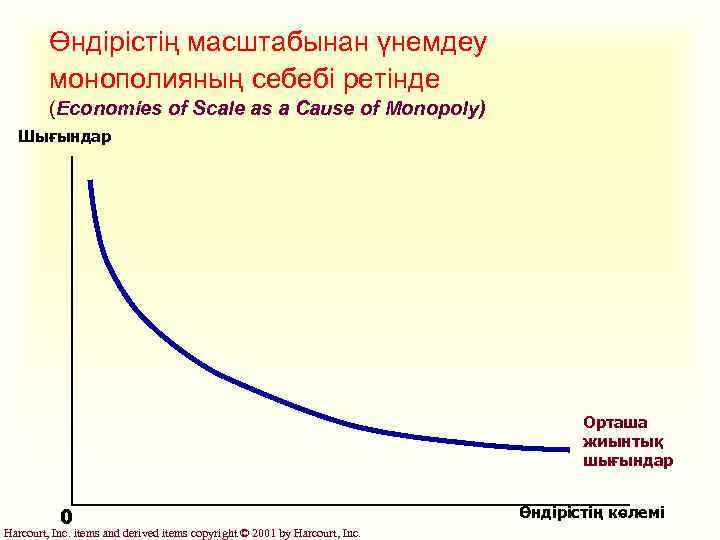 Өндірістің масштабынан үнемдеу монополияның себебі ретінде (Economies of Scale as a Cause of Monopoly) Шығындар Орташа жиынтық шығындар 0 Harcourt, Inc. items and derived items copyright © 2001 by Harcourt, Inc. Өндірістің көлемі
Өндірістің масштабынан үнемдеу монополияның себебі ретінде (Economies of Scale as a Cause of Monopoly) Шығындар Орташа жиынтық шығындар 0 Harcourt, Inc. items and derived items copyright © 2001 by Harcourt, Inc. Өндірістің көлемі
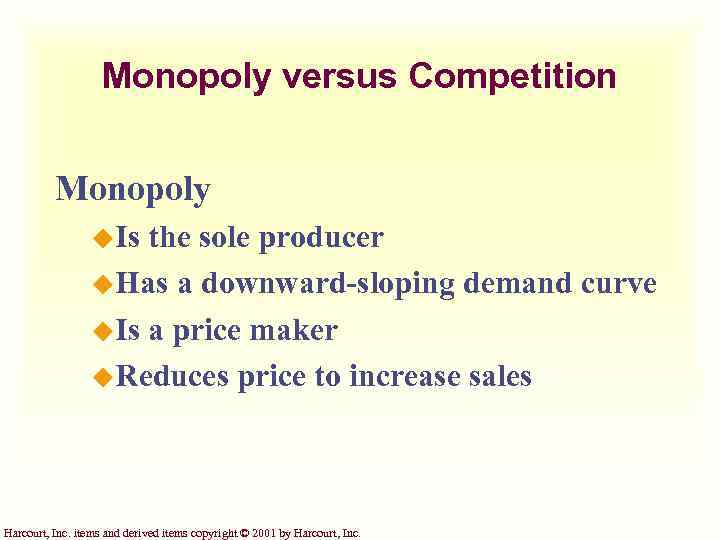 Monopoly versus Competition Monopoly u. Is the sole producer u. Has a downward-sloping demand curve u. Is a price maker u. Reduces price to increase sales Harcourt, Inc. items and derived items copyright © 2001 by Harcourt, Inc.
Monopoly versus Competition Monopoly u. Is the sole producer u. Has a downward-sloping demand curve u. Is a price maker u. Reduces price to increase sales Harcourt, Inc. items and derived items copyright © 2001 by Harcourt, Inc.
 Competition versus Monopoly Competitive Firm u. Is one of many producers u. Has a horizontal demand curve u. Is a price taker u. Sells as much or as little at same price Harcourt, Inc. items and derived items copyright © 2001 by Harcourt, Inc.
Competition versus Monopoly Competitive Firm u. Is one of many producers u. Has a horizontal demand curve u. Is a price taker u. Sells as much or as little at same price Harcourt, Inc. items and derived items copyright © 2001 by Harcourt, Inc.
 Бәсекелес және монополиялық фирмалары ұшін сұраныс қисығы (Demand Curves for Competitive and Monopoly Firms) (a) Бәсекелес фирманың сұраныс қисығы Баға (b)Монополиялық фирманың сұраныс қисығы Баға Сұраныс 0 Өндірістің көлемі Harcourt, Inc. items and derived items copyright © 2001 by Harcourt, Inc. 0 Өндірістің көлемі
Бәсекелес және монополиялық фирмалары ұшін сұраныс қисығы (Demand Curves for Competitive and Monopoly Firms) (a) Бәсекелес фирманың сұраныс қисығы Баға (b)Монополиялық фирманың сұраныс қисығы Баға Сұраныс 0 Өндірістің көлемі Harcourt, Inc. items and derived items copyright © 2001 by Harcourt, Inc. 0 Өндірістің көлемі
 Монополияның табысы (A Monopoly’s Revenue) Ø Жалпы табыс TR = P x Q = TR Ø Орташа табыс AR = TR/Q = AR = P Ø Маржиналды табыс MR= DTR/DQ = MR Harcourt, Inc. items and derived items copyright © 2001 by Harcourt, Inc.
Монополияның табысы (A Monopoly’s Revenue) Ø Жалпы табыс TR = P x Q = TR Ø Орташа табыс AR = TR/Q = AR = P Ø Маржиналды табыс MR= DTR/DQ = MR Harcourt, Inc. items and derived items copyright © 2001 by Harcourt, Inc.
 Монополиялық фирманың жиынтық, орташа және маржиналды шығындары (A Monopoly’s Total, Average, and Marginal Revenue) Quantity (Q) 0 1 2 3 4 5 6 7 8 Price (P) $11. 00 $10. 00 $9. 00 $8. 00 $7. 00 $6. 00 $5. 00 $4. 00 $3. 00 Total Revenue (TR=Px. Q) $0. 00 $18. 00 $24. 00 $28. 00 $30. 00 $28. 00 $24. 00 Harcourt, Inc. items and derived items copyright © 2001 by Harcourt, Inc. Average Revenue (AR=TR/Q) Marginal Revenue (MR= DTR / DQ ) $10. 00 $9. 00 $8. 00 $7. 00 $6. 00 $5. 00 $4. 00 $3. 00 $10. 00 $8. 00 $6. 00 $4. 00 $2. 00 $0. 00 -$2. 00 -$4. 00
Монополиялық фирманың жиынтық, орташа және маржиналды шығындары (A Monopoly’s Total, Average, and Marginal Revenue) Quantity (Q) 0 1 2 3 4 5 6 7 8 Price (P) $11. 00 $10. 00 $9. 00 $8. 00 $7. 00 $6. 00 $5. 00 $4. 00 $3. 00 Total Revenue (TR=Px. Q) $0. 00 $18. 00 $24. 00 $28. 00 $30. 00 $28. 00 $24. 00 Harcourt, Inc. items and derived items copyright © 2001 by Harcourt, Inc. Average Revenue (AR=TR/Q) Marginal Revenue (MR= DTR / DQ ) $10. 00 $9. 00 $8. 00 $7. 00 $6. 00 $5. 00 $4. 00 $3. 00 $10. 00 $8. 00 $6. 00 $4. 00 $2. 00 $0. 00 -$2. 00 -$4. 00
 Мононполистің маржиналды табысы (A Monopoly’s Marginal Revenue) Монополисттің маржиналды табысы әрқашанда оның тауарының бағасынан аз. ØМонополисттің өніміне сұраныс қисығы теріс наклон. ØМонополист сату көлемін ұлғайту үшін өзінің өнімінің бағасын төмендетуі қажет. Harcourt, Inc. items and derived items copyright © 2001 by Harcourt, Inc.
Мононполистің маржиналды табысы (A Monopoly’s Marginal Revenue) Монополисттің маржиналды табысы әрқашанда оның тауарының бағасынан аз. ØМонополисттің өніміне сұраныс қисығы теріс наклон. ØМонополист сату көлемін ұлғайту үшін өзінің өнімінің бағасын төмендетуі қажет. Harcourt, Inc. items and derived items copyright © 2001 by Harcourt, Inc.
 Монополистің маржиналды табысы (A Monopoly’s Marginal Revenue) Монополист сату көлемін ұлғайту үшін оның жалпы табысқа (P x Q) әсер ететін екі эффектімен ұшырайды: Ø Өндірістің көлемінің эффектісі: шығарылған өнімнің үлкен көлемі сатылады, Q өседі. Ø Баға эффектісі, баға P төмендейді. Harcourt, Inc. items and derived items copyright © 2001 by Harcourt, Inc.
Монополистің маржиналды табысы (A Monopoly’s Marginal Revenue) Монополист сату көлемін ұлғайту үшін оның жалпы табысқа (P x Q) әсер ететін екі эффектімен ұшырайды: Ø Өндірістің көлемінің эффектісі: шығарылған өнімнің үлкен көлемі сатылады, Q өседі. Ø Баға эффектісі, баға P төмендейді. Harcourt, Inc. items and derived items copyright © 2001 by Harcourt, Inc.
 Монополияның маржиналды табысы және сұраныс қисығы (Demand Marginal Revenue Curves for a Monopoly) Price $11 10 9 8 7 6 5 4 3 2 1 0 -1 -2 -3 -4 Сұраныс (Орташа табыс) Маржиналды табыс 1 2 3 4 5 6 7 8 Quantity of Water
Монополияның маржиналды табысы және сұраныс қисығы (Demand Marginal Revenue Curves for a Monopoly) Price $11 10 9 8 7 6 5 4 3 2 1 0 -1 -2 -3 -4 Сұраныс (Орташа табыс) Маржиналды табыс 1 2 3 4 5 6 7 8 Quantity of Water
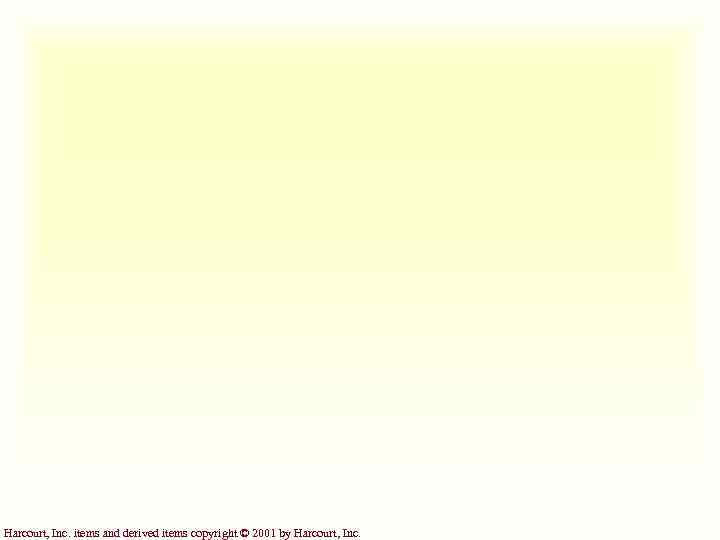 Harcourt, Inc. items and derived items copyright © 2001 by Harcourt, Inc.
Harcourt, Inc. items and derived items copyright © 2001 by Harcourt, Inc.
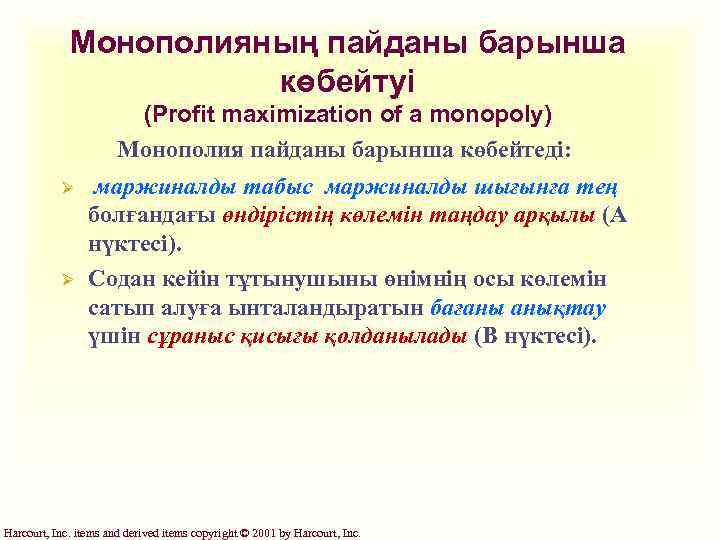 Монополияның пайданы барынша көбейтуі (Profit maximization of a monopoly) Монополия пайданы барынша көбейтеді: Ø Ø маржиналды табыс маржиналды шығынға тең болғандағы өндірістің көлемін таңдау арқылы (A нүктесі). Содан кейін тұтынушыны өнімнің осы көлемін сатып алуға ынталандыратын бағаны анықтау үшін сұраныс қисығы қолданылады (В нүктесі). Harcourt, Inc. items and derived items copyright © 2001 by Harcourt, Inc.
Монополияның пайданы барынша көбейтуі (Profit maximization of a monopoly) Монополия пайданы барынша көбейтеді: Ø Ø маржиналды табыс маржиналды шығынға тең болғандағы өндірістің көлемін таңдау арқылы (A нүктесі). Содан кейін тұтынушыны өнімнің осы көлемін сатып алуға ынталандыратын бағаны анықтау үшін сұраныс қисығы қолданылады (В нүктесі). Harcourt, Inc. items and derived items copyright © 2001 by Harcourt, Inc.
 Harcourt, Inc. items and derived items copyright © 2001 by Harcourt, Inc. Монополияның пайданы барынша көбейтуі (Profit-Maximization for a Monopoly) 2. . Сонда сұраныстың қисығы осы өндірістің көлеміне сәйкес келетін бағаны көрсетеді Costs and Revenue Monopoly price B 1. Маржиналды табыстың қисығы мен маржиналды шығындардың қисығының қиылысу нүктесі өндірістің көлемінің барынша көп пайдасын анықтайды Average total cost A Demand Marginal cost Marginal revenue 0 QMAX Quantity
Harcourt, Inc. items and derived items copyright © 2001 by Harcourt, Inc. Монополияның пайданы барынша көбейтуі (Profit-Maximization for a Monopoly) 2. . Сонда сұраныстың қисығы осы өндірістің көлеміне сәйкес келетін бағаны көрсетеді Costs and Revenue Monopoly price B 1. Маржиналды табыстың қисығы мен маржиналды шығындардың қисығының қиылысу нүктесі өндірістің көлемінің барынша көп пайдасын анықтайды Average total cost A Demand Marginal cost Marginal revenue 0 QMAX Quantity
 Монополияның пайданы барынша көбейтуі Бәсекелес фирма үшін : Р= МR= MC Ø Монополия фирма үшін: P > MR = MC Ø Harcourt, Inc. items and derived items copyright © 2001 by Harcourt, Inc.
Монополияның пайданы барынша көбейтуі Бәсекелес фирма үшін : Р= МR= MC Ø Монополия фирма үшін: P > MR = MC Ø Harcourt, Inc. items and derived items copyright © 2001 by Harcourt, Inc.
 A Monopoly’s Profit equals total revenue minus total costs. Profit = TR - TC Profit = (TR/Q - TC/Q) x Q Profit = (P - ATC) x Q Harcourt, Inc. items and derived items copyright © 2001 by Harcourt, Inc.
A Monopoly’s Profit equals total revenue minus total costs. Profit = TR - TC Profit = (TR/Q - TC/Q) x Q Profit = (P - ATC) x Q Harcourt, Inc. items and derived items copyright © 2001 by Harcourt, Inc.
 Harcourt, Inc. items and derived items copyright © 2001 by Harcourt, Inc. The Monopolist’s Profit. . . Costs and Revenue Marginal cost Average total cost D B y ol op it on f M pro Monopoly E price Average total cost C Demand Marginal revenue 0 QMAX Quantity
Harcourt, Inc. items and derived items copyright © 2001 by Harcourt, Inc. The Monopolist’s Profit. . . Costs and Revenue Marginal cost Average total cost D B y ol op it on f M pro Monopoly E price Average total cost C Demand Marginal revenue 0 QMAX Quantity
 The Market for Drugs. . . Costs and Revenue Price during patent life Price after patent expires 0 Marginal revenue Monopoly quantity Harcourt, Inc. items and derived items copyright © 2001 by Harcourt, Inc. Competitive quantity Marginal cost Demand Quantity
The Market for Drugs. . . Costs and Revenue Price during patent life Price after patent expires 0 Marginal revenue Monopoly quantity Harcourt, Inc. items and derived items copyright © 2001 by Harcourt, Inc. Competitive quantity Marginal cost Demand Quantity
 The Monopolist’s Profit The monopolist will receive economic profits as long as price is greater than average total cost. Harcourt, Inc. items and derived items copyright © 2001 by Harcourt, Inc.
The Monopolist’s Profit The monopolist will receive economic profits as long as price is greater than average total cost. Harcourt, Inc. items and derived items copyright © 2001 by Harcourt, Inc.
 The Welfare Cost of Monopoly u. In contrast to a competitive firm, the monopoly charges a price above the marginal cost. u. From the standpoint of consumers, this high price makes monopoly undesirable. u. However, from the standpoint of the owners of the firm, the high price makes monopoly very desirable. Harcourt, Inc. items and derived items copyright © 2001 by Harcourt, Inc.
The Welfare Cost of Monopoly u. In contrast to a competitive firm, the monopoly charges a price above the marginal cost. u. From the standpoint of consumers, this high price makes monopoly undesirable. u. However, from the standpoint of the owners of the firm, the high price makes monopoly very desirable. Harcourt, Inc. items and derived items copyright © 2001 by Harcourt, Inc.
 The Efficient Level of Output. . . Price Marginal cost Value to buyers Cost to monopolist 0 Demand (value to buyers) Efficient quantity Value to buyers is greater than cost to seller. Harcourt, Inc. items and derived items copyright © 2001 by Harcourt, Inc. Value to buyers is less than cost to seller. Quantity
The Efficient Level of Output. . . Price Marginal cost Value to buyers Cost to monopolist 0 Demand (value to buyers) Efficient quantity Value to buyers is greater than cost to seller. Harcourt, Inc. items and derived items copyright © 2001 by Harcourt, Inc. Value to buyers is less than cost to seller. Quantity
 The Deadweight Loss Because a monopoly sets its price above marginal cost, it places a wedge between the consumer’s willingness to pay and the producer’s cost. u. This wedge causes the quantity sold to fall short of the social optimum. Harcourt, Inc. items and derived items copyright © 2001 by Harcourt, Inc.
The Deadweight Loss Because a monopoly sets its price above marginal cost, it places a wedge between the consumer’s willingness to pay and the producer’s cost. u. This wedge causes the quantity sold to fall short of the social optimum. Harcourt, Inc. items and derived items copyright © 2001 by Harcourt, Inc.
 Harcourt, Inc. items and derived items copyright © 2001 by Harcourt, Inc. The Inefficiency of Monopoly. . . Price Deadweight loss Marginal cost Monopoly price Marginal revenue 0 Monopoly Efficient quantity Demand Quantity
Harcourt, Inc. items and derived items copyright © 2001 by Harcourt, Inc. The Inefficiency of Monopoly. . . Price Deadweight loss Marginal cost Monopoly price Marginal revenue 0 Monopoly Efficient quantity Demand Quantity
 The Inefficiency of Monopoly The monopolist produces less than the socially efficient quantity of output. Harcourt, Inc. items and derived items copyright © 2001 by Harcourt, Inc.
The Inefficiency of Monopoly The monopolist produces less than the socially efficient quantity of output. Harcourt, Inc. items and derived items copyright © 2001 by Harcourt, Inc.
 The Deadweight Loss u. The deadweight loss caused by a monopoly is similar to the deadweight loss caused by a tax. u. The difference between the two cases is that the government gets the revenue from a tax, whereas a private firm gets the monopoly profit. Harcourt, Inc. items and derived items copyright © 2001 by Harcourt, Inc.
The Deadweight Loss u. The deadweight loss caused by a monopoly is similar to the deadweight loss caused by a tax. u. The difference between the two cases is that the government gets the revenue from a tax, whereas a private firm gets the monopoly profit. Harcourt, Inc. items and derived items copyright © 2001 by Harcourt, Inc.
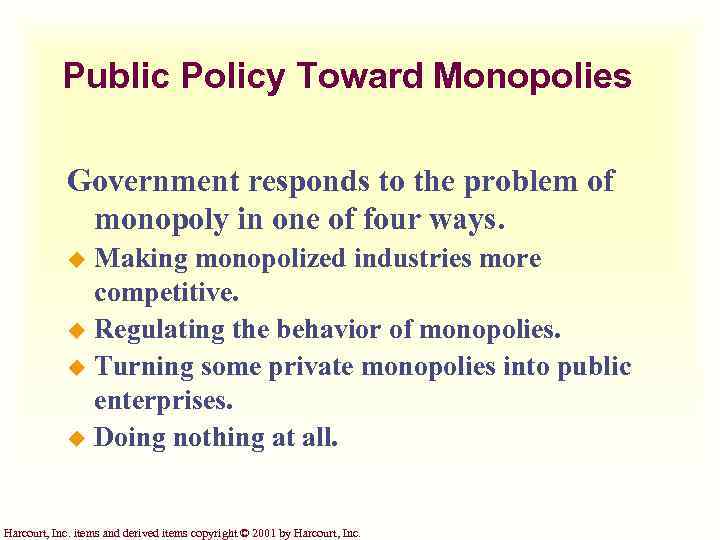 Public Policy Toward Monopolies Government responds to the problem of monopoly in one of four ways. Making monopolized industries more competitive. u Regulating the behavior of monopolies. u Turning some private monopolies into public enterprises. u Doing nothing at all. u Harcourt, Inc. items and derived items copyright © 2001 by Harcourt, Inc.
Public Policy Toward Monopolies Government responds to the problem of monopoly in one of four ways. Making monopolized industries more competitive. u Regulating the behavior of monopolies. u Turning some private monopolies into public enterprises. u Doing nothing at all. u Harcourt, Inc. items and derived items copyright © 2001 by Harcourt, Inc.
 Increasing Competition with Antitrust Laws u Antitrust laws are a collection of statutes aimed at curbing monopoly power. u Antitrust laws give government various ways to promote competition. u They allow government to prevent mergers. u They allow government to break up companies. u They prevent companies from performing activities which make markets less competitive. Harcourt, Inc. items and derived items copyright © 2001 by Harcourt, Inc.
Increasing Competition with Antitrust Laws u Antitrust laws are a collection of statutes aimed at curbing monopoly power. u Antitrust laws give government various ways to promote competition. u They allow government to prevent mergers. u They allow government to break up companies. u They prevent companies from performing activities which make markets less competitive. Harcourt, Inc. items and derived items copyright © 2001 by Harcourt, Inc.
 Two Important Antitrust Laws u Sherman Antitrust Act (1890) u Reduced the market power of the large and powerful “trusts” of that time period. u Clayton Act (1914) u Strengthened the government’s powers and authorized private lawsuits. Harcourt, Inc. items and derived items copyright © 2001 by Harcourt, Inc.
Two Important Antitrust Laws u Sherman Antitrust Act (1890) u Reduced the market power of the large and powerful “trusts” of that time period. u Clayton Act (1914) u Strengthened the government’s powers and authorized private lawsuits. Harcourt, Inc. items and derived items copyright © 2001 by Harcourt, Inc.
 Regulation Government may regulate the prices that the monopoly charges. u. The allocation of resources will be efficient if price is set to equal marginal cost. Harcourt, Inc. items and derived items copyright © 2001 by Harcourt, Inc.
Regulation Government may regulate the prices that the monopoly charges. u. The allocation of resources will be efficient if price is set to equal marginal cost. Harcourt, Inc. items and derived items copyright © 2001 by Harcourt, Inc.
 Marginal-Cost Pricing for a Natural Monopoly. . . Price Average total cost Regulated price Loss Average total cost Marginal cost Demand 0 Harcourt, Inc. items and derived items copyright © 2001 by Harcourt, Inc. Quantity
Marginal-Cost Pricing for a Natural Monopoly. . . Price Average total cost Regulated price Loss Average total cost Marginal cost Demand 0 Harcourt, Inc. items and derived items copyright © 2001 by Harcourt, Inc. Quantity
 Regulation In practice, regulators will allow monopolists to keep some of the benefits from lower costs in the form of higher profit, a practice that requires some departure from marginal-cost pricing. Harcourt, Inc. items and derived items copyright © 2001 by Harcourt, Inc.
Regulation In practice, regulators will allow monopolists to keep some of the benefits from lower costs in the form of higher profit, a practice that requires some departure from marginal-cost pricing. Harcourt, Inc. items and derived items copyright © 2001 by Harcourt, Inc.
 Public Ownership Rather than regulating a natural monopoly that is run by a private firm, the government can run the monopoly itself. (e. g. in the U. S. , the government runs the Postal Service). Harcourt, Inc. items and derived items copyright © 2001 by Harcourt, Inc.
Public Ownership Rather than regulating a natural monopoly that is run by a private firm, the government can run the monopoly itself. (e. g. in the U. S. , the government runs the Postal Service). Harcourt, Inc. items and derived items copyright © 2001 by Harcourt, Inc.
 Doing Nothing Government can do nothing at all if the market failure is deemed small compared to the imperfections of public policies. Harcourt, Inc. items and derived items copyright © 2001 by Harcourt, Inc.
Doing Nothing Government can do nothing at all if the market failure is deemed small compared to the imperfections of public policies. Harcourt, Inc. items and derived items copyright © 2001 by Harcourt, Inc.
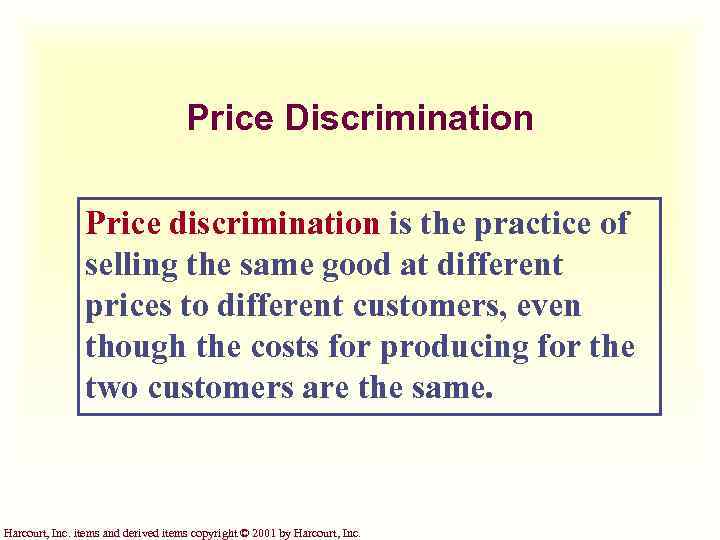 Price Discrimination Price discrimination is the practice of selling the same good at different prices to different customers, even though the costs for producing for the two customers are the same. Harcourt, Inc. items and derived items copyright © 2001 by Harcourt, Inc.
Price Discrimination Price discrimination is the practice of selling the same good at different prices to different customers, even though the costs for producing for the two customers are the same. Harcourt, Inc. items and derived items copyright © 2001 by Harcourt, Inc.
 Price Discrimination Price discrimination is not possible when a good is sold in a competitive market since there are many firms all selling at the market price. In order to price discriminate, the firm must have some market power. Harcourt, Inc. items and derived items copyright © 2001 by Harcourt, Inc.
Price Discrimination Price discrimination is not possible when a good is sold in a competitive market since there are many firms all selling at the market price. In order to price discriminate, the firm must have some market power. Harcourt, Inc. items and derived items copyright © 2001 by Harcourt, Inc.
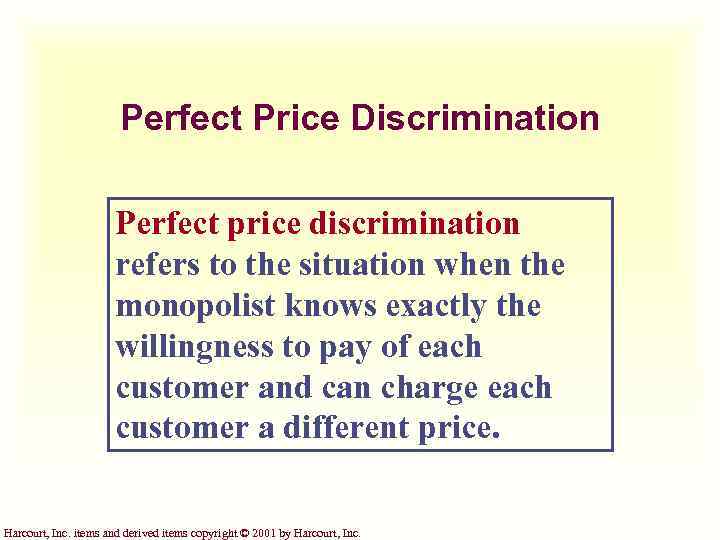 Perfect Price Discrimination Perfect price discrimination refers to the situation when the monopolist knows exactly the willingness to pay of each customer and can charge each customer a different price. Harcourt, Inc. items and derived items copyright © 2001 by Harcourt, Inc.
Perfect Price Discrimination Perfect price discrimination refers to the situation when the monopolist knows exactly the willingness to pay of each customer and can charge each customer a different price. Harcourt, Inc. items and derived items copyright © 2001 by Harcourt, Inc.
 Price Discrimination u Two important effects of price discrimination: u It can increase the monopolist’s profits. u It can reduce deadweight loss. Harcourt, Inc. items and derived items copyright © 2001 by Harcourt, Inc.
Price Discrimination u Two important effects of price discrimination: u It can increase the monopolist’s profits. u It can reduce deadweight loss. Harcourt, Inc. items and derived items copyright © 2001 by Harcourt, Inc.
 Welfare Without Price Discrimination. . . (a) Monopolist with Single Price Consumer surplus Monopoly price Deadweight loss Profit Marginal cost Marginal revenue 0 Quantity sold Harcourt, Inc. items and derived items copyright © 2001 by Harcourt, Inc. Demand Quantity
Welfare Without Price Discrimination. . . (a) Monopolist with Single Price Consumer surplus Monopoly price Deadweight loss Profit Marginal cost Marginal revenue 0 Quantity sold Harcourt, Inc. items and derived items copyright © 2001 by Harcourt, Inc. Demand Quantity
 Welfare With Price Discrimination. . . Price (b) Monopolist with Perfect Price Discrimination Profit Marginal cost Demand 0 Quantity sold Harcourt, Inc. items and derived items copyright © 2001 by Harcourt, Inc. Quantity
Welfare With Price Discrimination. . . Price (b) Monopolist with Perfect Price Discrimination Profit Marginal cost Demand 0 Quantity sold Harcourt, Inc. items and derived items copyright © 2001 by Harcourt, Inc. Quantity
 Examples of Price Discrimination u Movie tickets u Airline prices u Discount coupons u Financial aid u Quantity discounts Harcourt, Inc. items and derived items copyright © 2001 by Harcourt, Inc.
Examples of Price Discrimination u Movie tickets u Airline prices u Discount coupons u Financial aid u Quantity discounts Harcourt, Inc. items and derived items copyright © 2001 by Harcourt, Inc.
 The Prevalence of Monopoly u How prevalent are the problems of monopolies? u Monopolies are common. u Most firms have some control over their prices because of differentiated products. u Firms with substantial monopoly power are rare. u Few goods are truly unique. Harcourt, Inc. items and derived items copyright © 2001 by Harcourt, Inc.
The Prevalence of Monopoly u How prevalent are the problems of monopolies? u Monopolies are common. u Most firms have some control over their prices because of differentiated products. u Firms with substantial monopoly power are rare. u Few goods are truly unique. Harcourt, Inc. items and derived items copyright © 2001 by Harcourt, Inc.
 Summary u. A monopoly is a firm that is the sole seller in its market. u It faces a downward-sloping demand curve for its product. u A monopoly’s marginal revenue is always below the price of its good. Harcourt, Inc. items and derived items copyright © 2001 by Harcourt, Inc.
Summary u. A monopoly is a firm that is the sole seller in its market. u It faces a downward-sloping demand curve for its product. u A monopoly’s marginal revenue is always below the price of its good. Harcourt, Inc. items and derived items copyright © 2001 by Harcourt, Inc.
 Summary u Like a competitive firm, a monopoly maximizes profit by producing the quantity at which marginal cost and marginal revenue are equal. u Unlike a competitive firm, its price exceeds its marginal revenue, so its price exceeds marginal cost. Harcourt, Inc. items and derived items copyright © 2001 by Harcourt, Inc.
Summary u Like a competitive firm, a monopoly maximizes profit by producing the quantity at which marginal cost and marginal revenue are equal. u Unlike a competitive firm, its price exceeds its marginal revenue, so its price exceeds marginal cost. Harcourt, Inc. items and derived items copyright © 2001 by Harcourt, Inc.
 Summary u. A monopolist’s profit-maximizing level of output is below the level that maximizes the sum of consumer and producer surplus. u A monopoly causes deadweight losses similar to the deadweight losses caused by taxes. Harcourt, Inc. items and derived items copyright © 2001 by Harcourt, Inc.
Summary u. A monopolist’s profit-maximizing level of output is below the level that maximizes the sum of consumer and producer surplus. u A monopoly causes deadweight losses similar to the deadweight losses caused by taxes. Harcourt, Inc. items and derived items copyright © 2001 by Harcourt, Inc.
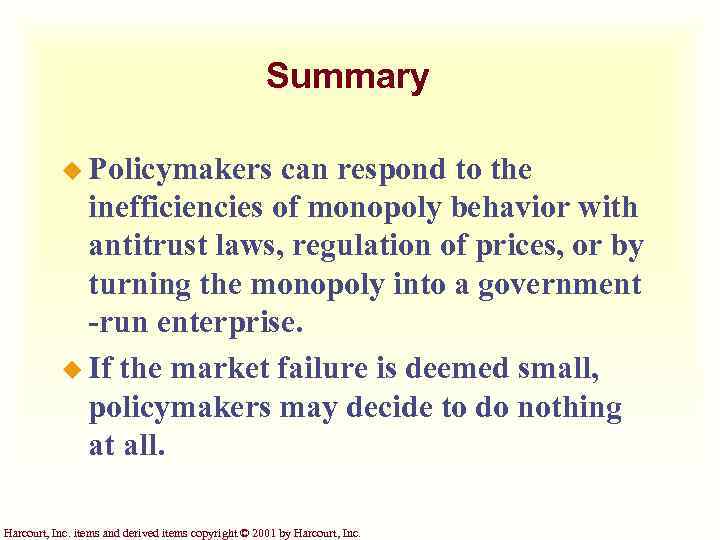 Summary u Policymakers can respond to the inefficiencies of monopoly behavior with antitrust laws, regulation of prices, or by turning the monopoly into a government -run enterprise. u If the market failure is deemed small, policymakers may decide to do nothing at all. Harcourt, Inc. items and derived items copyright © 2001 by Harcourt, Inc.
Summary u Policymakers can respond to the inefficiencies of monopoly behavior with antitrust laws, regulation of prices, or by turning the monopoly into a government -run enterprise. u If the market failure is deemed small, policymakers may decide to do nothing at all. Harcourt, Inc. items and derived items copyright © 2001 by Harcourt, Inc.
 Summary u Monopolists can raise their profits by charging different prices to different buyers based on their willingness to pay. u Price discrimination can raise economic welfare and lessen deadweight losses. Harcourt, Inc. items and derived items copyright © 2001 by Harcourt, Inc.
Summary u Monopolists can raise their profits by charging different prices to different buyers based on their willingness to pay. u Price discrimination can raise economic welfare and lessen deadweight losses. Harcourt, Inc. items and derived items copyright © 2001 by Harcourt, Inc.
 Graphical Review Harcourt, Inc. items and derived items copyright © 2001 by Harcourt, Inc.
Graphical Review Harcourt, Inc. items and derived items copyright © 2001 by Harcourt, Inc.
 Economies of Scale as a Cause of Monopoly. . . Cost Average total cost 0 Harcourt, Inc. items and derived items copyright © 2001 by Harcourt, Inc. Quantity of Output
Economies of Scale as a Cause of Monopoly. . . Cost Average total cost 0 Harcourt, Inc. items and derived items copyright © 2001 by Harcourt, Inc. Quantity of Output
 Demand Curves for Competitive and Monopoly Firms. . . Price (a) A Competitive Firm’s Demand Curve (b) A Monopolist’s Demand Curve Price Demand 0 Quantity of Output Harcourt, Inc. items and derived items copyright © 2001 by Harcourt, Inc. 0 Quantity of Output
Demand Curves for Competitive and Monopoly Firms. . . Price (a) A Competitive Firm’s Demand Curve (b) A Monopolist’s Demand Curve Price Demand 0 Quantity of Output Harcourt, Inc. items and derived items copyright © 2001 by Harcourt, Inc. 0 Quantity of Output
 Harcourt, Inc. items and derived items copyright © 2001 by Harcourt, Inc. Demand Marginal Revenue Curves for a Monopoly. . . Price $11 10 9 8 7 6 5 4 3 2 1 0 -1 -2 -3 -4 Demand (average revenue) Marginal revenue 1 2 3 4 5 6 7 8 Quantity of Water
Harcourt, Inc. items and derived items copyright © 2001 by Harcourt, Inc. Demand Marginal Revenue Curves for a Monopoly. . . Price $11 10 9 8 7 6 5 4 3 2 1 0 -1 -2 -3 -4 Demand (average revenue) Marginal revenue 1 2 3 4 5 6 7 8 Quantity of Water
 Harcourt, Inc. items and derived items copyright © 2001 by Harcourt, Inc. Profit-Maximization for a Monopoly. . . 2. . and then the demand curve shows the price consistent with this quantity. Costs and Revenue B Monopoly price 1. The intersection of the marginal-revenue curve and the marginalcost curve determines the profit-maximizing quantity. . . Average total cost A Demand Marginal cost Marginal revenue 0 QMAX Quantity
Harcourt, Inc. items and derived items copyright © 2001 by Harcourt, Inc. Profit-Maximization for a Monopoly. . . 2. . and then the demand curve shows the price consistent with this quantity. Costs and Revenue B Monopoly price 1. The intersection of the marginal-revenue curve and the marginalcost curve determines the profit-maximizing quantity. . . Average total cost A Demand Marginal cost Marginal revenue 0 QMAX Quantity
 Harcourt, Inc. items and derived items copyright © 2001 by Harcourt, Inc. The Monopolist’s Profit. . . Costs and Revenue Marginal cost Average total cost D B y ol op it on f M pro Monopoly E price Average total cost C Demand Marginal revenue 0 QMAX Quantity
Harcourt, Inc. items and derived items copyright © 2001 by Harcourt, Inc. The Monopolist’s Profit. . . Costs and Revenue Marginal cost Average total cost D B y ol op it on f M pro Monopoly E price Average total cost C Demand Marginal revenue 0 QMAX Quantity
 The Market for Drugs. . . Costs and Revenue Price during patent life Price after patent expires 0 Marginal revenue Monopoly quantity Harcourt, Inc. items and derived items copyright © 2001 by Harcourt, Inc. Competitive quantity Marginal cost Demand Quantity
The Market for Drugs. . . Costs and Revenue Price during patent life Price after patent expires 0 Marginal revenue Monopoly quantity Harcourt, Inc. items and derived items copyright © 2001 by Harcourt, Inc. Competitive quantity Marginal cost Demand Quantity
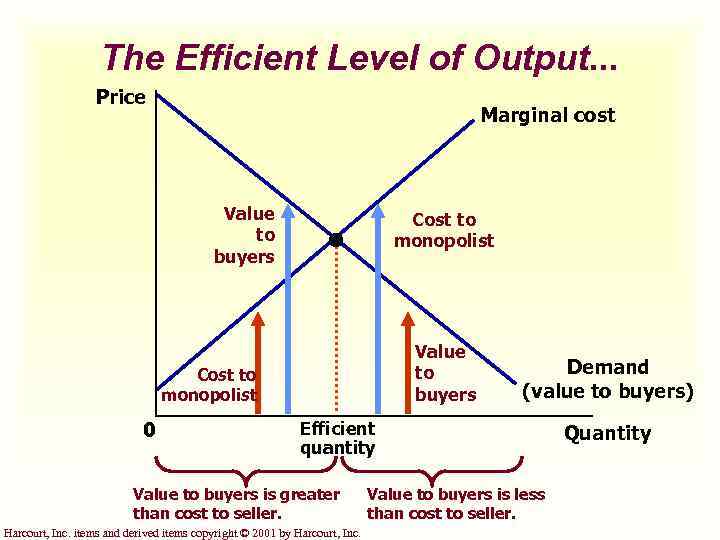 The Efficient Level of Output. . . Price Marginal cost Value to buyers Cost to monopolist 0 Demand (value to buyers) Efficient quantity Value to buyers is greater than cost to seller. Harcourt, Inc. items and derived items copyright © 2001 by Harcourt, Inc. Value to buyers is less than cost to seller. Quantity
The Efficient Level of Output. . . Price Marginal cost Value to buyers Cost to monopolist 0 Demand (value to buyers) Efficient quantity Value to buyers is greater than cost to seller. Harcourt, Inc. items and derived items copyright © 2001 by Harcourt, Inc. Value to buyers is less than cost to seller. Quantity
 Harcourt, Inc. items and derived items copyright © 2001 by Harcourt, Inc. The Inefficiency of Monopoly. . . Price Deadweight loss Marginal cost Monopoly price Marginal revenue 0 Monopoly Efficient quantity Demand Quantity
Harcourt, Inc. items and derived items copyright © 2001 by Harcourt, Inc. The Inefficiency of Monopoly. . . Price Deadweight loss Marginal cost Monopoly price Marginal revenue 0 Monopoly Efficient quantity Demand Quantity
 Marginal-Cost Pricing for a Natural Monopoly. . . Price Average total cost Regulated price Loss Average total cost Marginal cost Demand 0 Harcourt, Inc. items and derived items copyright © 2001 by Harcourt, Inc. Quantity
Marginal-Cost Pricing for a Natural Monopoly. . . Price Average total cost Regulated price Loss Average total cost Marginal cost Demand 0 Harcourt, Inc. items and derived items copyright © 2001 by Harcourt, Inc. Quantity
 Welfare Without Price Discrimination. . . (a) Monopolist with Single Price Consumer surplus Monopoly price Deadweight loss Profit Marginal cost Marginal revenue 0 Quantity sold Harcourt, Inc. items and derived items copyright © 2001 by Harcourt, Inc. Demand Quantity
Welfare Without Price Discrimination. . . (a) Monopolist with Single Price Consumer surplus Monopoly price Deadweight loss Profit Marginal cost Marginal revenue 0 Quantity sold Harcourt, Inc. items and derived items copyright © 2001 by Harcourt, Inc. Demand Quantity
 Welfare With Price Discrimination. . . Price (b) Monopolist with Perfect Price Discrimination Profit Marginal cost Demand 0 Quantity sold Harcourt, Inc. items and derived items copyright © 2001 by Harcourt, Inc. Quantity
Welfare With Price Discrimination. . . Price (b) Monopolist with Perfect Price Discrimination Profit Marginal cost Demand 0 Quantity sold Harcourt, Inc. items and derived items copyright © 2001 by Harcourt, Inc. Quantity


